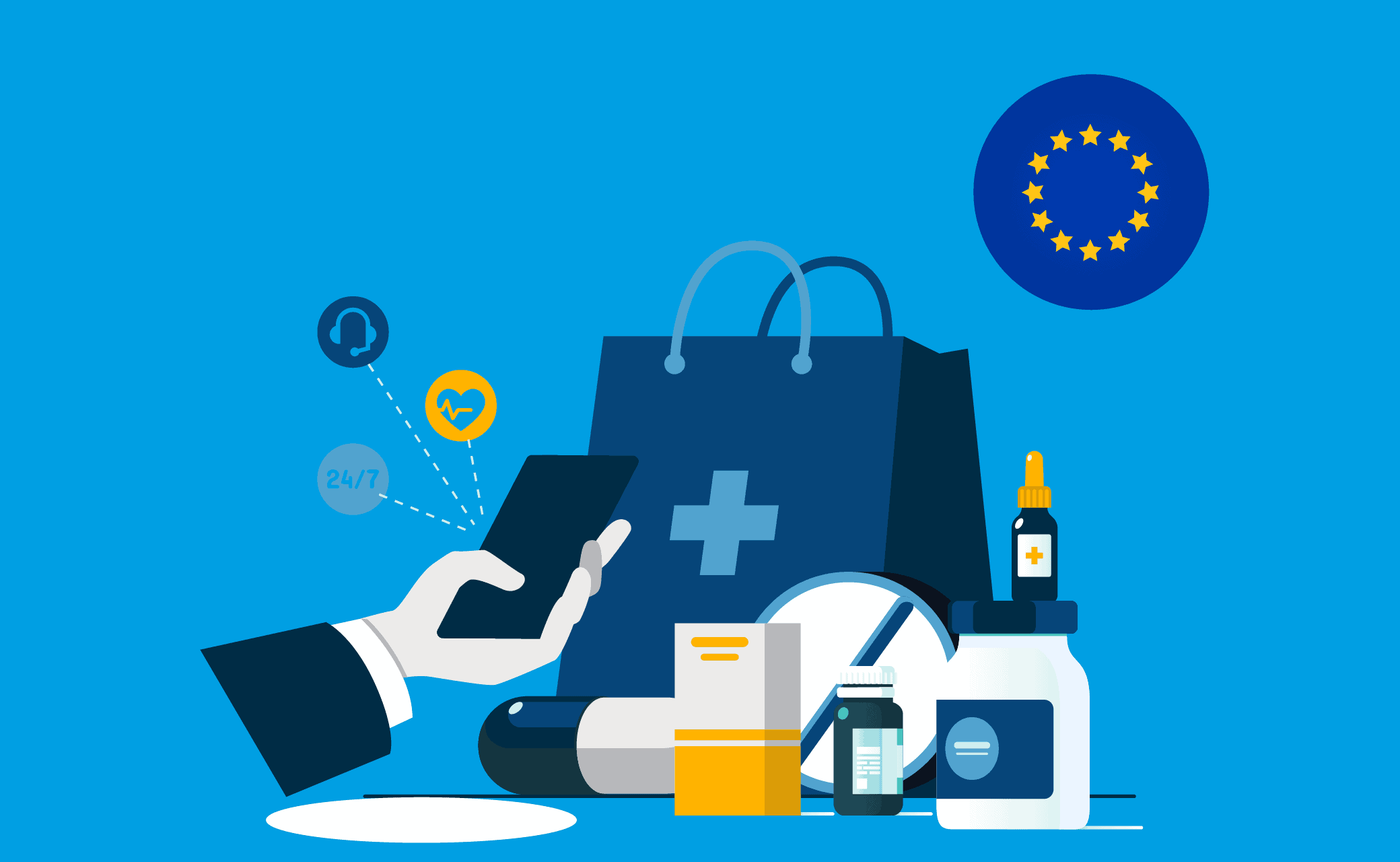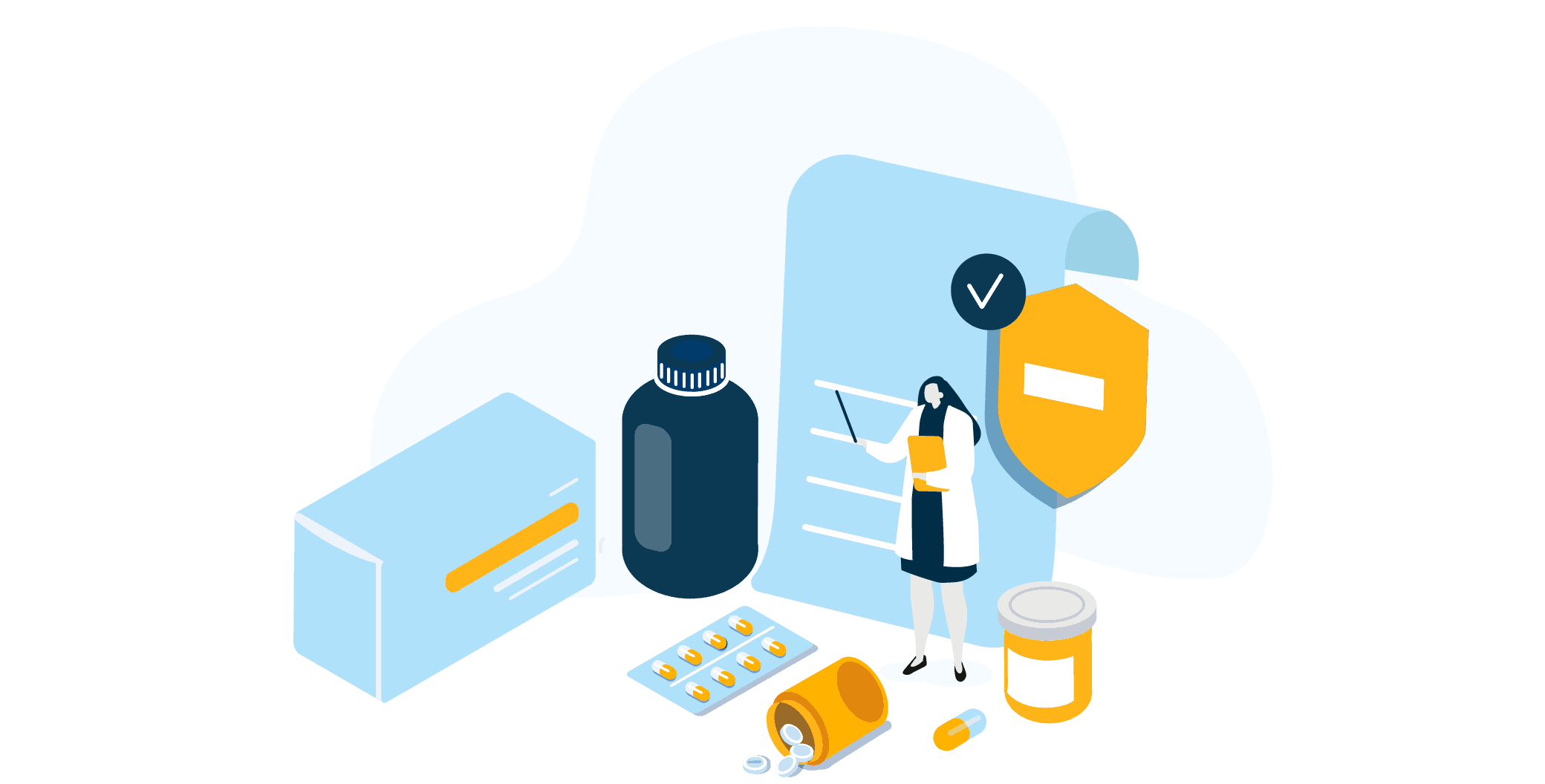How to accelerate your pharmaceutical product launch in Europe?

25 November 2021
BlueReg
BlueReg is an international pharma consultancy offering strategic regulatory advice and hands-on outsourcing solutions to life sciences companies through a multitude of services from Product development to life cycle management, Early Access Programs and more. We are experienced in supporting our clients in all aspects of regulatory drug launches and look forward to sharing our knowledge and experience in this article.
We will cover the design of the regulatory strategy to prepare the launch sequence for your first pharmaceutical product in Europe. Moving onto compliance with the EU and local requirements after a centralized procedure and ending with the coordination and set up of a tailored outsourcing regulatory platform.
Regulatory strategy for a successful launch
Regulatory strategy linked to a pharmaceutical product launch in EU can be extremely complex especially if it’s your very first medicinal product in the EU.
European Market Authorization
So, let’s start by the beginning.
Pharma companies may have several options to request a marketing authorization for a new drug in EU. One of these options, and if the product is eligible to this procedure, is the centralized route which will provide you a single marketing authorization in all EU countries. This marketing authorization is granted by the European commission following the scientific assessment of the application by the relevant committees at EMA.
Even if a pan-European Marketing authorization is granted, a large number of other local regulatory activities are still required prior to the commercial launch of your drug in the concerned country.
The necessity to be compliant at a global and a local level
The situation is even more complex when you are a start-up or when you are not yet based in EU. Our clients predominantly contact us during their development program to start discussion around registration and future launches in Europe. The difficulties they are facing is to be compliant to all local regulations of these European countries. They must implement a regulatory strategy which matches with the marketing expectations, the regulatory constraints and planning their future geographical roll-out in non-EU countries too.
Therefore, the coordination of all the stakeholders is required at both global and local levels, and of course, without having an appropriate representative at local level, it can be extremely difficult to execute your plan (mainly due to the barrier language, as part of the activities must be done only in local language).
Regulatory strategy consideration before product launches

Indeed, a number of different challenges must be considered when you start a launch plan.
First: it’s all about timing: when to start? And that can concern small companies, biotech but also more mature pharma companies, because every launch has their own characteristics linked to the product and each launch can be different.
You may also consider the strategy and go for an early access program. It’s very often the case for orphan drugs for example. But in this case, you would also need to think about the transition period between your EAP and your future commercial launch.
The launch sequence from a regulatory point of view should be well organized considering the kind of resources and the main stakeholders you would need at global and local levels.
You need to understand the local requirements to differentiate what is absolutely mandatory for the launch and what would be nice to have or even can be set up later?
You must consider all requirements linked to your product. For example, to launch a biologic which will be only distributed in hospitals is not the same situation as for a small molecule available in pharmacy only.
Finally, it’s crucial to anticipate the impact of your initial launch in EU for the rest of the world in terms of price for example.
Key elements to consider for pharma companies

To provide with an initial overview, here are some key elements to consider complying with regulatory requirements during product launch:
1. All data to be reported in the packaging such as the Blue Box and the national code, which should be prioritized to enable a rapid manufacture of your drug
2. The serialization and all the complexity around the SKUs and shared packs
3. The local representative for PV, scientific services, or other responsibilities, which can be mandatory
4. The notification of your launch at national level
5. The registration of your products in local databases
6. The preparation of your congresses and communication plan with your promotional material, or even the local review and approval of some educational materials
…. And, as you can imagine, most of these activities must be handled in local languages, so not so easy.
How to plan Regulatory affairs activities of your new drug?
One word is key: ANTICIPATION!!!
Because you need to plan well in advance what will happen on your future markets for upcoming new drugs.
That should be part of your registration plan where you determine with your marketing colleagues which countries will be prioritized for the product launch, and when it’s possible, if there is a need to plan for an Early Access Program as well.
Once this prioritization is made, you need to collect the local requirements in terms of regulatory, but also Pharmacovigilance or Quality and get a good understanding of what should be set up first.
A robust product launch strategy is required to handle any regulatory hurdles and challenges and make sure that all stakeholders are aligned.
A sustainable communication to the launch team on what is permissible in each market at each stage of the registration and launch is also required.
You also need to assess your internal resources versus the immediate needs in terms of skills, but also where a local presence is required. You need to budget appropriately and fill in the gap with appropriate recruitments or relevant external partners.
Planning of activities for local market
And what’s about timelines when a centralized procedure is used for registration of your drug?
Careful consideration must be given for the timing of each country activity to ensure rate limiting steps and potential delays are minimized.
Indeed, some activities can be initiated well before the European Commission Decision, but the situation will vary country by country.
For example:
In Germany the local code, the PZN, can be requested before the CHMP opinion to start the preparation of the serialisation. The educational materials must be translated when the CHMP opinion is issued for immediate national submission for review in order to be able to get approved documents for launch.
In Italy, the local code, the SIS code, can also be requested before CHMP opinion and once obtained the appointment of the proxy can be made, this is one of the requirements in Italy. However, submission of educational materials will occur post EC decision.
And it’s just two simple examples of the variabilities by country and the reason why your launch plan should also be developed and described in detail at the local level.
Main Regulatory Requirements for European drug launches

Let's take a concrete example and have a look at the main regulatory, quality & PV requirements to launch your medicinal product in Europe.
Local Compliance - Market Realities
The EMA has delivered one Marketing authorization for thirty European countries. The Marketing authorization is compliant to the European guidelines, but to launch your product, you must consider:
- Thirty local variations due to local laws and guidelines
- Thirty different local health Agencies
- Thirty different National health systems
- Twenty-five different languages
To add further complexity to the situation, the United Kingdom left Europe in 2020, but in practice, the United Kingdom is now split into two different territories Great Britain & Northern Ireland
- Great Britain which represents England, Wales and Scotland, where MHRA guidelines and laws must be followed and where a local Marketing authorization must be obtained
- Northern Ireland where European rules are still applicable, and Norther Ireland can be considered as a European member state.
In another words, with your centralized Marketing Authorization, you can launch your product in Northern Ireland whereas, you need a local approved Marketing Authorization to launch your product in Great Britain. Note that, a lot of Great Britain requirements are still awaited and are planned to be published this year. This can have an impact on your product launch success.
Anticipate the launch sequence - Success Factors to drug launches

When your medicinal product is under evaluation, as mentioned earlier, it is recommended to anticipate the launch sequence. This is applicable for all types of products and all types of procedures (centralized, Mutual recognition, decentralized or national procedures).
The requirements are globally the same. Here are the main requirements for a product which will be or has been approved through the centralized procedure.
Product launches requirements are:
1. Local representative (Regulatory affairs, Pharmacovigilance and or scientific services)
2. National code
3. Blue box
4. Serialisation
5. Local database
6. Local launch date notification
7. Promotional materials
8. Educational materials
9. The need of a Local wholesale distribution authorization (WDA)
10. Shared pack and SKUs
To be compliant to all these requirements the regulatory department will work with different stakeholders such as market access, legal, commercial teams and supply chain.
Local representatives

The need for a local representative is country and activity dependent, depending upon the local law, it can be someone in Regulatory Affairs, and / or in Pharmacovigilance and / or in scientific services. The qualifications required by function are not the same in all the European countries (it can be a pharmacist, a doctor or a scientific person with very high level of skills in the concerned area) that is required to fulfil these positions.
The regulatory affairs representative is generally in charge of the regulatory actions at the local level, such as to complete the local database in local language, obtain the national code and the blue box validation when required. In some of the European countries, like in France, Germany and Spain, a notification must be submitted to the local competent authority to name the concerned person.
In pharmacovigilance, as per European law, it is mandatory to have a European Qualified Person in Pharmacovigilance (EU QPPV). Depending on the country, here again there is a need to have somebody at local level and often to declare this person to the local competent authority. This is the case for example in France, Spain, Italy. Here again the qualification required may vary by country, but in any case, it should be someone with recognized skills in Pharmacovigilance. In some other countries, even if it is not required, it is strongly recommended to have a local Pharmacovigilance representative to support the EU QPPV especially in case of safety issues.
At the global level the Scientific services is responsible for the advertising materials compliance. At the local level, the requirements are the same and depending on the concerned European country, this person must be notified to the local competent authority.
All these three activities (Regulatory, Pharmacovigilance and scientific services) can be subcontracted to third parties when this resource is not in place within your company. For local launch all the quality agreements / contracts must be in place by country for the local representatives.
For some markets the role is mandatory but for other markets it is only advised.
For example, in Germany it is mandatory to have appointed an information officer to cover regulatory and scientific services activities, whereas a local contact person in pharmacovigilance is only strongly recommended. In Spain, it is mandatory to have a local representative in all the three functions.
National code
The requirements for the national code vary throughout Europe. Depending on the country it can be requested as soon as the positive opinion from the CHMP is issue or after obtaining the European Commission decision. The timeline to obtain it varied by country (from few days to several months). This code enables identification of the product by the packaging. This code is globally applicable in western countries (such as Spain, France, Portugal, Italy, Nordics, Germany).
The number of digits is defined by the individual country and sometimes, the code can be linked to the pricing and reimbursement status. When a national code is required by the local regulations and laws, generally it must be printed in a specific area of the blue box on the outer packaging.
For example, in Germany the national code is called the PZN. It can be requested as soon as the CHMP positive opinion is given. To be obtained, other local codes must be obtained first.
1. The PNR which is a pharmaceutical company number for the MAH
2. The ENR which is the BfArM submission number for the product
To obtain these numbers, forms must be completed in German and submitted to the local competent authority. The PNR and ENR are obtained generally in less than one week, the PZN is obtained in few days. Just before the launch, the PZN must be activated, and updated forms must be submitted in-line with the German calendar.
Blue box
The "blue box" is a boxed area included in the labelling, with a blue border, containing compulsory information specific to each Member State. It is defined in the EU guidelines, and it is mandatory to have it printed on the outer packaging. The blue box must contain local language only, thus in case of shared pack, it’s mandatory to have further blue boxes on the packaging.
It can be a “simple” blue box with only the country name and national code, this is the case for example in the Nordics countries.
In other countries such as in France or in Spain, the legal status, warnings, symbols and pictograms must be also included. The pictograms are mainly linked to the ability to drive and operate machinery and to pregnancy. In both countries (Spain & France) the blue box must be validated by the national competent authority.
The blue box has an important impact on the layout of the outer packaging, and depending on the size of the outer packaging, the blue box requirements may impact the shared pack and your launch strategy. Companies must consider this point well in advance to discuss and negotiate potential solutions with the EMA but also with the local agencies if required.
Serialisation
With the implementation of the Falsified Medicines Directive in February two o nineteen, the serialisation is now mandatory for all prescription products (excluding those mentioned in the Annex 1 of the Directive).
The serialisation is characterized by:
- Unique Identifier (UI)
→ Which is an alphanumerical code to allow the identification and authentication of individual packs
→ The UI will be defined further on the next slide
- Anti-Tampering Device (ATD)
→ Device allowing the verification of whether a pack has been opened/tampered with.
Serialisation is a requirement for all European countries except in Greece & Italy where national rules are applicable until two o twenty-five. In Greece, the Greek code (EOF code) is required in line with local regulations, whereas in Italy a bollino (a sticker with the local national code printed) must be added on the outer packaging.
The unique identifier is defined through 4 data lines and is also represented using the Datamatrix:
1. The product code or PC
2. The serial number which is given by the manufacturing site
3. The batch numbers
4. The expiry dates
The product code itself, is defined by the national code if available, and the national code is generally embedded into the product code. For a country where no national code is used, the product code is defined with the support of Global Standards 1, the GS1 code can also be used in case of a shared pack.
To exchange the coding data with all the stakeholders, the Marketing Authorisation Holder (MAH) must be registered in the European Medicines Verification System (EMVS) and in each National Medicines Verification System (NMVS) where the product will be launched.
Contracts must be signed & fees must be paid at EU & at national level. Note that a dedicated contact point person with an MAH email address is mandatory to register the MAH.
Local database
Here again, the requirements are country dependent. In some EU countries, the registration in the public database is completed automatically without any MAH action. This is the case in France & in the UK at ANSM & MHRA level.
In other countries, it’s mandatory for the MAH to record the product in the local database. This is the case in Spain & in Sweden. Basically, without this registration, your MA does not exist at the local level.
Finally, it is also recommended to register your product in paid database as applicable per the local market, as they are well used by the HCPs. This is the case with the Vidal in France & with the RoteListe in Germany. Choice of voluntary local databases is a company decision which can be linked to the marketing strategy.
Local launch date notification
Even if the marketing status is submitted at the EMA level, in some European countries the local launch date must be also notified to the national competent authority. It can be a simple notification in the database like in Spain & in Sweden or it can be a required formal declaration submitted to the national competent authority like in France & Germany. The submission is generally managed by the local representative in a defined time frame.
Promotional materials

Advertising & Promotional activities have become so key to commercial success of drug launch and launch strategies - we have already posted an article to provide a comprehensive overview of the promotional communication associated to your drug launch strategy in Europe and explain what promotional compliance means for those looking to market their products in this region.
In Europe, the advertising for prescription products is only authorized for health care professionals. Companies are not allowed to promote their product to the patients. The advertising is supervised by three types of guidelines.
- At the worldwide level by the International Federation of Pharmaceutical Manufacturers and Associations (IFPMA)
- At the European level by the European Federation of Pharmaceutical Industries and Associations (EFPIA)
- At the local level where local code and or law are applicable.
A dedicated person from the scientific services with specific roles and responsibilities depending on the country is responsible of the advertising materials. Promotional materials may need to be validated by the national competent authority and it is not possible to use materials without this validation. In France, submission to the national Agency is necessary, whereas in Germany, the materials can be used as soon as it has been approved by the dedicated person (the information officer in this case). In the UK, the materials must be reviewed by the MHRA if requested (under the Vetting procedure), but in any case, the material must be signed as per the ABPI code. Each country has very specific rules which must be followed very carefully to ensure compliance.
Educational materials
During the assessment, if educational materials are required with the new product, even if the EMA validates the English version, each member state must validate the national educational materials which will be distributed / used by the patients and / or the health care professionals. Approval must be obtained before the local launch. Methods of submission, timelines, fees etc. are again countries dependent. As example, in Germany, the blue hand must be added on the educational material, and in Slovakia and Czechia only the local pharmacovigilance representatives can submit the materials for approval to the local competent authority.
Wholesale distribution authorization (WDA)
A European wholesale distribution authorization is required to distribute the product within the EU However in some EU countries, to be able to launch the product, it is mandatory to have a local distribution license. The location of the warehouse may also have an impact on whether a local WDA is required (as an example, in Sweden a local wholesaler license is required if the medicinal product is distributed directly to hospitals without a pharmacy with a license from the Swedish Agency).
The distribution of this activity can be sub-contracted as required when local company infrastructure is not in place. All agreements, contracts, roles and responsibilities must be in place for the product launch and any activities are undertaken.
Shared packs and SKU
To rationalize the number of European commercial packs required, the use of shared packs is allowed providing local requirements are followed. There are no defined guidelines to create the SKU and the shared pack. This is a company decision. The EMA has validated a template of the 3 languages mock-ups, which can be referred to for any mixed packs with different languages. Nonetheless, by experience the shared pack are generally used for:
- Benelux countries (as they need German, French and Dutch languages)
- German pack for Germany and Austria
- Iberia pack (Spain & Portugal)
- Baltics pack (for Estonia, Latvia & Lithuania)
- Nordics pack (for Sweden, Finland and Denmark or Sweden, Finland and Norway as in Sweden it is also mandatory to have Finish in the packaging)
Companies may wish to have further shared packs based on projected sales and distribution plans which are acceptable providing the packaging is compliant with all the rules (in term of layout, blue boxes, serialisation and so on).
Outsourcing regulatory platform to ensure successful launch

As you have seen, market launch is complex, and it is essential to be well planned early in your submission process to ensure optimize launch performance. Of course, one of the very first questions is how to coordinate and how do you handle all these tasks? What activities should we start with to successfully launch new drugs?
First a global launch team organization must be set up. This global team will be a cross functional collaboration composed of the key representatives required to prepare the pharmaceutical product launch. Of course, there should be a Regulatory representative to provide the general EU input but also to be the voice of all the local regulatory contacts. Then, generally, you will see the corresponding functions for legal, manufacturing, supply chain, quality, marketing, market access, PV and medical. They may not be involved at each meeting but should be assigned to represent their function and available for questions.
This Global launch team should set up the governance for all other processes and provide an oversight of the launch strategy to the Executive Committee of your company.
In addition to this team, specific local launch teams must be set up too, and for each country where you plan to undertake a product launch. Similar functions should be represented to address local challenges, and most of the time, when you are at the start of the creation of your affiliate you may even have the general manager around the table as the sole local representative.
The key challenge for your first product launch is the difficulty to fulfil all the roles at the local or even global levels when you have a small organization and therefore no direct access to more resources. The recruitment can still be ongoing or even have not commenced yet. In addition, the required roles may not need a full resource initially or are able to be covered by one resource which can make recruitment planning very complex.
In this kind of situation just outlined, what could be the best methodology to successfully launch?
Indeed, it is essential to have a deep understanding of the local specificities. And the easiest way to do that, when you don’t have affiliates or agents to represent your company at local levels, is to externalize the regulatory resources through an outsourcing platform. They will collect the local requirements for the product launch and beyond. That will enable you to focus & analyze the gaps and address issues by sourcing internally or delegate the responsibilities to a third party.
This third party can manage the entire process in conjunction with your team or they can provide a regulatory support to your company and can also fulfil all local national roles for successful market launch and beyond.
More concretely, what does this mean for your company?
Well, at the EU level you need to select the appropriate resources who may be a combination of your internal staff and external resources to centrally coordinate local partners and company staff. That will ensure the quality of your launch program. You need to align action plans versus the timelines set up with your marketing colleagues with all other stakeholders and propose corrective actions in a flexible manner.
At the country level, you need to set up a strategy per country to match with these timelines. Develop corresponding local SOPs, tracking tools and RACI tables. With the support of local partners and company staff, the team members will prepare and review the local documents in local languages, partners will submit on your behalf at local level and interact with the local agency if needed or even can act as a local representative as required for PV or quality for example.
So, as you can see, when your structure is not fully staffed in Europe, or even when you’re a more mature company, the European complexities are such, that the support of an outsourcing platform with the advice of experts in the different activities can be critically important for product launch success.
One mistake and you can potentially miss your key milestones and do not reach launch expectations, expected sales.
Based on the BlueReg launch experience, we would recommend the following for any outsourced product launch projects:
1. Set up a strong governance & project management to ensure a constant quality and adherence of your agreed timelines & product launch strategies
2. Ensure that the appropriate staffing skills and profiles are present around the table and at each different steps of your product launch, as the requirements may evolve over time
3. Establish a strong and long-term relationship between your company and the chosen partners. Trust & loyalty from both sides are essential for the success of your product launch
4. The governance should be set at the global level, but the local plan must be determined at the country level. You all know the quote “think globally and act locally” and it’s really true in the present situation.
At BlueReg we support numerous clients for their launches in Europe and we know how the right advice, at the right time with a tailored coordination corresponding to your organization is so critically important for the success of all your launches in the pharmaceutical industry.
Pharmaceutical Product Launch in Europe: Anticipation & Expertise

Pharmaceutical Companies after successful clinical trials during drug development will be looking to maximize their product value once their product is approved by health authorities. In fact, market research shows that the biggest expenses of pharma companies are related to new launches for drugs approved especially for indication where there might be intense competition.
Carefully planning drug launches can become a competitive advantage as you will be able to go faster and prevent any delays regarding your product launch strategy.
The anticipation of your launch is key to succeed, especially in an increasingly complex regulatory environment as EU, but you also need to ensure that your team is well prepared and has a clear understanding of the requirements.
As explained, all the European requirements but also the local requirements of every targeted market must be fulfilled before any product launches, in another word, one marketing authorization but thirty different launch plans to be set-up with local constraints.
There are a lot of complexities in the local rules, one of them is the language barrier. Without a local support it can be difficult to launch according to appropriate timelines. All the stakeholders (supply, legal, regulatory affairs, market access and so on) must be involved in the launch planning.
What will be applicable for one country will be different in another.
As a regulatory consultancy, BlueReg support their clients in such activities on a daily basis for the project management, the local requirements and the setup of the local representatives when required. No two launches are the same, so our operational teams are ready to work with you to review product-specific plans. We can adopt services needed to reduce delay to get product on the market and stay compliant. we would be very pleased to exchange further on our experience with you so please don't hesitate to




